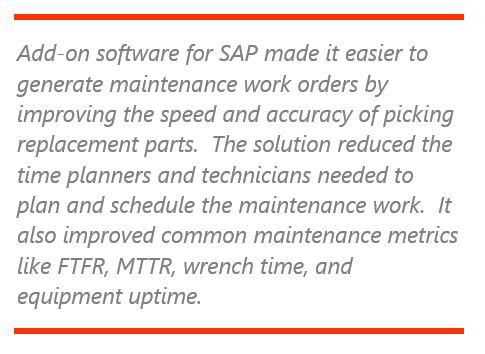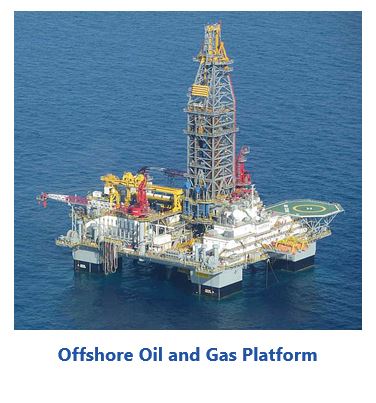

The recent SAP-Centric EAM conference included a presentation by a global oil and gas major with over 
Offshore oil platforms support exploration, extraction, storage, and processing of petroleum and natural gas from beneath the seabed. The nature of these operations involves extracting volatile substances, sometimes under extreme pressure, in a hostile environment.
A typical oil production platform is self-sufficient in its energy and water needs. The large structure includes an extensive array of equipment and related assets to perform all functions. This includes housing electrical generation and water desalination facilities, and the equipment needed to extract, process, and transfer oil and gas. Logistical, safety, and housing issues motivate exploration & production companies to locate as many of their personnel as possible in onshore remote operations centers. This includes maintenance personnel.
Since the maintenance staff and spare parts are located onshore, a wrong or missing part sent to an oil platform for a repair with the maintenance crew has major ramifications. The repair must be halted while support personnel scramble to identify the part and its inventory status. If available, the part is located and sent out to the rig via helicopter. If not available, the asset is closed, and the work order rescheduled. Either way, this substantially increases maintenance costs, mean time to repair (MTTR), and downtime – with potentially lost production and associated revenues.

Attempts to find the right parts were error-prone. Selecting parts for a work order required laborious searching in the parts database, which contains several million items. Planners would read through the vendor documentation to find the vendor’s part number, which is often different from the part manufacturer’s number. Part descriptions were in an obtuse alphanumeric format that was hard to interpret. Each person depended on his or her own institutional knowledge based on the repairs they were involved in previously.
The poor documentation resulted in significant man-hours needed to research, validate, and order parts. Inaccuracies in the MMRs and BOMs caused delays, rework, and poor-quality repairs. Also, they often deferred to buying the parts from the equipment supplier using the OEM’s proprietary part numbers. This negated the opportunity for a purchasing contract volume discounts with a distributor using standard part numbers. This would result in excess maintenance spend and management attention. When the maintenance work order had wrong or missing parts, the associated delays reduced production and revenue.
The company’s solution for improving the data quality for drawings and parts involved a combination of software to manage the data and services to obtain and load the data. HubHead’s NRX AssetVisualizer manages the documents and parts lists. It integrates seamlessly with the SAP maintenance management software by appearing as an icon in the appropriate SAP screens. This integration also provides hotlinks from the vendor diagram to the parts list in AssetVisualizer and links to MMRs in SAP for procurement.
A broad array of people involved in maintaining the equipment on the platforms felt the pain caused by poor data quality. The project involved stakeholders at the appropriate times during the project planning and implementation. These included maintenance planners, maintenance technicians, and EAM master data owners. Since extended downtime affected revenues, executive management support was obtained.
Implementation involved obtaining the data, loading it into NRX AssetVisualizer, and then linking it to SAP. Related activities included:
If allowed to, data quality will decay over time, which would likely eventually lead to failure of this project and reverting to the old way of identifying parts for a maintenance work order. To sustain high data quality, the management of change business processes and governance now includes updating NRX AssetVisualizer when new equipment is obtained or when recommended spare parts change.
The first platform project has been successfully completed and management approval has been obtained to roll out the solution to additional platforms. The initial platform benefits include:
To obtain information about the equipment, contractors contacted the vendors for documentation and parts lists. Unfortunately, many of the vendors did not understand that they were engaged with the oil and gas company and were slow to respond. When oil and gas company employees engaged, the response was much faster. Engaging employees with the vendors early to explain the program and being clear on why contractors will be calling them would have avoided some implementation costs and delays.
Engage stakeholders up front for planning – particularly when the initial parts book was available for demo. Obtain their feedback and incorporate their suggestions where possible. If not, explain why.
The parts book system works within maintenance and procurement personnel’s existing workflow. Parts in AssetVisualizer are linked to MMRs in SAP. With this ease-of-use, user training was minimized across a diverse set of roles and computer skills.
With the low data quality prior to the project, BOMs in SAP were not usable. This poor documentation was pervasive and introduced errors, reduced productivity, and constrained performance. The NRX AssetVisualizer provides an illustrated parts book that stores the data and assures it is not lost – a one-time effort is required for loading and is then available for as long as the equipment is in operation. Maintenance operations and uptime has improved on the first platform with improved performance and reliability. Executive management approval has been obtained to extend the program to other platforms.
ARC Advisory Group clients can view the complete report at ARC Client Portal
If you would like to buy this report or obtain information about how to become a client please Contact Us
Keywords: SAP, EAM Conference, HubHead, NRX AssetVisualizer, Offshore Platform, Platform Maintenance, ARC Advisory Group.

